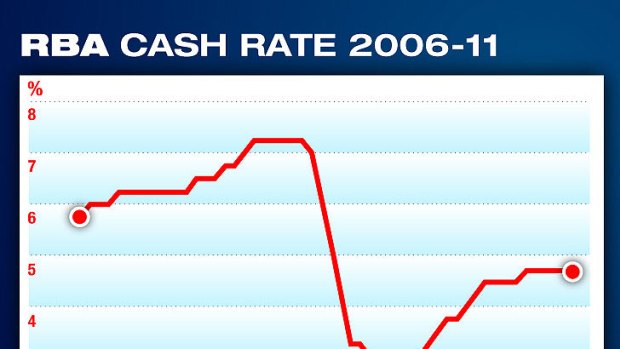By Chris Zappone
Update Home owners can rest easy for another month after the Reserve Bank decided to keep official interest rates on hold - again.
The cash rate has been at 4.75 per cent since November last year, when the RBA delivered a Melbourne Cup-day shock to borrowers by increasing the cash rate by a quarter of a percentage point.

RBA cash rate
- Home loan, borrowing, repayment calculators
- Chronology of interest rate moves since 1990
- Glenn Stevens' statement: why the RBA stayed put
- Economists' view on RBA decision
- Michael Pascoe sees pressure mounting for a rate rise
It had been widely expected the bank would hold its fire on rates today, with many economists predicting no movement until mid-year, possibly May, and the credit market pricing in roughly one quarter-percentage point rise over the next 12 months.
“The RBA seemed pretty bullish on the economic outlook,” said Commonwealth Bank senior economist John Peters.
“We suspect the RBA will move to lift rates again before the mid year.” Mr Peters expects one rate rise by May with another two increases taking the cash rate to 5.5 per cent by year’s end.
The Australian dollar eased back after the RBA announcement indicated the central bank holds little immediate concerns about rising inflation. It was recently buying about 101.6 US cents, down about a quarter of a US cent.
Modest inflation
Reserve Bank governor Glenn Stevens said inflation was likely to remain within its longer-term target range of 2 to 3 per cent, despite the huge floods in recent months. The higher Australian dollar was helping to contain costs by making imports cheaper, he said.
''Production losses due to weather are temporarily raising prices for some agricultural produce, but these should fall back later in the year,'' Mr Stevens said, in a statement accompanying the rates decision.
There is still a possibility the commercial banks could move independently and raise mortgage rates out of step with the central bank. Similar hikes in the past have prompted public and political outrage.
The central bank, though, may stay put for a while yet.
ANZ economist Riki Polygenis said the RBA’s comments about skills shortages showed the central bank could put off rate rises for a while longer.
“They don’t believe the mining investment boom is putting upward pressure on capacity,” Ms Polygenis. “At this point in time, we’re seeing mixed outcomes across the economy.''
“That’s welcome news for the RBA. If some areas of the economy remain weak there is more room to accommodate the mining and infrastructure booms coming,” she said.
GDP outlook
Australia's economy, already one of the world's best performing, is likely to get a further boost this year as exports of agricultural products, minerals and energy rise another 14 per cent to $250 billion, the government's commodity forecaster said today.
Indeed, the latest December-quarter statistics out in the past two days are prompting some economists to lift their growth forecasts ahead of tomorrow's release of national accounts.
Before today's release of trade and state spending figures for the final three months of 2010, Westpac, for instance, had been expecting gross domestic product to post a 0.8 per cent increase for the period, compared with consensus estimates of 0.6 per cent.
Westpac now expects the number to come in at 1.1 per cent, compared with the 0.2 per cent expansion in the September quarter.
Retail figures for January out today also suggest the economy has so far weathered much of the impact from massive floods and cyclones over the past month or so. Retail sales rose 0.4 per cent for the month, up from 0.2 per cent registered in December.
Mr Stevens noted that rising commodity prices had been pushing up consumer price inflation in many countries. As a result, ''a number of countries have been moving to tighten their monetary policy settings,'' he said.
China, Australia's largest trading partner, is among nations to lift interest rates in recent weeks.
Mr Stevens noted that Australia's terms of trade - the ratio of export prices to import prices - are ''at their highest level since the early 1950s and national income is growing strongly''.
Households, though, are saving more as they remain cautious in spending and borrowing, Mr Stevens said.
''Asset values have generally been little changed over recent months and overall credit growth remains quite subdued, notwithstanding evidence of some greater willingness to lend,'' Mr Stevens. ''Business balance sheets generally are being strengthened, and the run-up in household leverage has abated.''
Mr Stevens ruled out a major impact to the economy from the widespread flooding in Queensland and other states in recent months.
''The effects of the natural disasters over the summer have reduced output, but production levels should recover over the months ahead, and there will be a mild boost to demand from the rebuilding efforts as they get under way,'' he said.
czappone@fairfax.com.au
BusinessDay